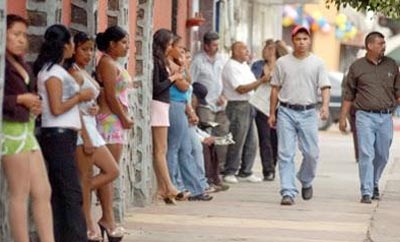Walk down calle Coahuila, and in the distance, you can see the landmark avenida Revolucion clock under a monumental arch. But really, perhaps Tijuana is even more famous for hedonism signaled by the posters and signs lining Coahuila. It seems every other door leads to a “hotel” with a smattering of bars and gentleman’s clubs, and even, for the romantic at heart, a flower shop. Inside, many of the women, teens and girls who work in the sex trade are slaves to international criminal organizations.
The principal business of Chinese mafias in Baja is human trafficking, mainly of women and girls, according to the director of municipal public security in Tijuana, Marco Antonio Carrillo Maza. But Carrillo and others also acknowledge that Chinese gangs smuggle endangered species of animals, contraband goods (including pirated products and fake name brands), as well as opium and chemicals used in the manufacture of methamphetamines. The Barrio de la Chinesca in Mexicali is a vital center for Chinese organized crime, just steps from the U.S. border (marked in yellow on the map below). Police confirmed for SPC that there are undocumented cellars and underground tunnels in the neighborhood, so people and goods can move from point to point unseen.
This article is reprinted from an investigation by Southern Pulse. Full report avaliable here.
Marco Antonio Vizcarra Calderón, local congressional representative from the Partido Estatal de Baja California told SPC that in conversations with other local leaders, he learned the going rate to admit one undocumented Chinese citizen to Mexico was US$1,000, offered to politicians and even the Delegación del Instituto Nacional de Migración. Some of his peers emphasized the strength of the Chinese mafia, derived in part from the growing wealth of their homeland.

Some girls and teens held captive by the Chinese mafia in Baja are local, but many are brought from other parts of the world. Bar “Hong Kong,” in Tijuana, owned by Mario Garcia Franco, was mentioned as a brothel where trafficked women and girls are forced to work in the sex trade, though other businesses on avenida Coahuila run similar operations. Some trafficking victims stay in Baja permanently, but frequently gangs keep trafficking victims in Baja just for a temporary “training” period before they send them on to the United States, Japan or other destination countries. Marisa Ugarte, director of the Tijuana-San Diego Binational Safery Corridor Coalition (BSCC), noted that Chinese mafias in Baja California have strong ties to counterparts in the United States and Asia. Some brothels are co-owned by US citizens, but managed by residents of Mexico.
The problem is deeply entrenched in Baja’s border towns where the sex trade and human trafficking are enormously profitable — although there are NGOs like the BSCC that wrangle with the issue, for many in Baja it is simply a fact of life. And aside from the violence associated with managing prostitutes, Asian mafias are not violent. They shy away from the attention that killing and kidnapping could bring. Generally, members do not even participate in robbery or extortion schemes, so residents who don’t live in the nightlife district and don’t drive the streets where prostitutes hawk their bodies see other things as greater priorities.
SEE ALSO: Modern Slavery in Latin America
Drug trafficking is a top priority for law enforcement in northern Baja, and is another area where China is making inroads. The Baja state Security Secretary, Daniel de la Rosa Anaya, described a steady flow of precursor chemicals, used in the manufacture of synthetic drugs that
are shipped from China to Baja California, entering the ports of Manzanillo or Lázaro Cárdenas, and making their way north to Tijuana and Mexicali.
The Baja Security Secretary recognized that Chinese criminals are major players in a number of smuggling activities. He said they traffic in endangered animal species, including local species such as bighorn sheep (borrego cimarrón) and the fish totoaba, among others, which are
smuggled back to China. With China’s growing economy there is high demand for “exotic” cuisine, and many of the endangered animals end up as ingredients on the plates of China’s upper class.
Though they may be the most numerous and powerful, Chinese networks aren’t the only game in town — police report that Cambodian, Lao, and Thai groups also smuggle goods, including weapons, across the border. Those cells are particularly active in Playas de Tijuana, Popotla and Playas de Rosarito. Police say one clique of Thai criminals launder money at Asian restaurants in Mexicali.
Many Asians also operate in the “grey market” buying scrap metal, much of which is stolen, and shipping it to buyers in Asia, where metals like copper command a higher price. Some of the most extreme Asian criminal networks pay for the metal in drugs, and essentially task local addicts with stealing metal in exchange for a fix. One recycling establishment uses an “IOU” system: addicts exchange metal for a ticket they can redeem with local drug dealers, who are then reimbursed by the metal recyclers.
While they ship metal back across the Pacific, Chinese gangs smuggle other products north to California. Business owners confirm that it is easy to get merchandise across the border without export fees, paperwork, or even an inspection. One simply has to bribe Mexican customs agents who wave through Chinese textiles and appliances every day. Though newspapers regularly report on seizures of counterfeit cigarettes and brand-name clothing, SPC sources say many more shipments make it to the marketplace.
*Reprinted with permission from Southern Pulse. Full report available here.

